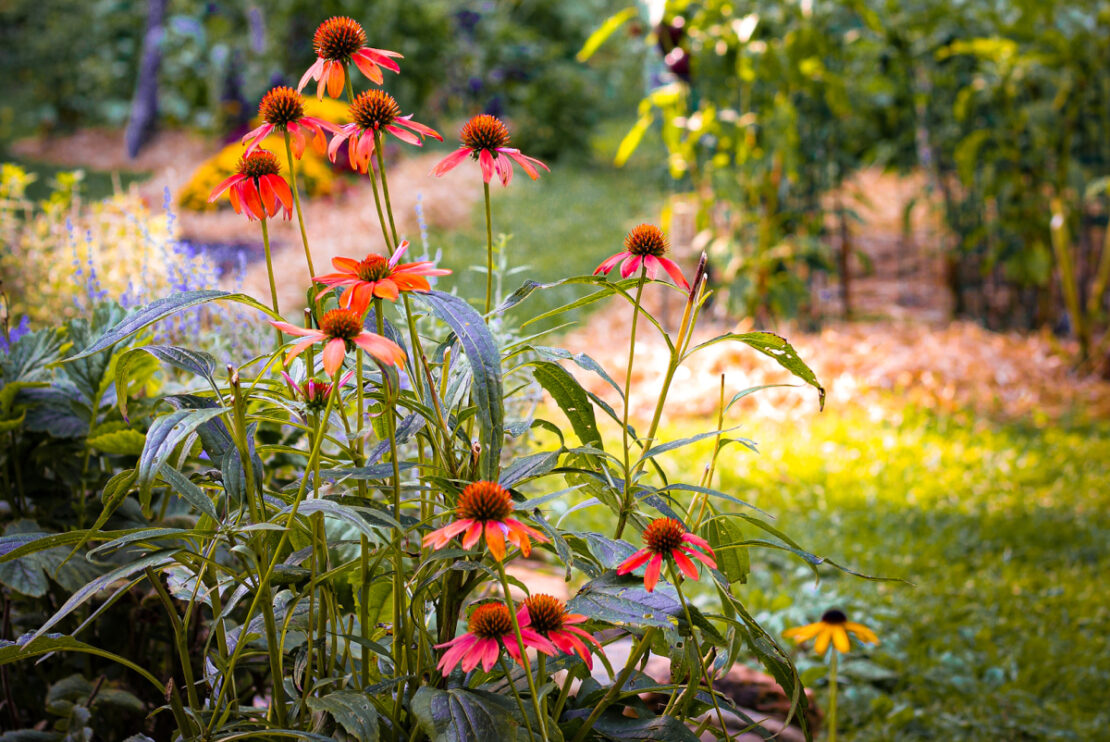
How to Grow Your Own Tea Garden + Helpful Harvesting Tips
It’s an Appalachian summer morning and the sun is just starting to peek its face over the mountain. I start my day in the tea garden. The tops of the trees glow gold while the valley is still cool and covered in dew. I wander through the garden, favorite mug in hand, snipping a bit of lemon balm (Melissa officinalis), blue vervain (Verbena hastata), tulsi (Ocimum tenuiflorum), and catnip (Nepeta cataria). Of course, I can’t forget to pick some yarrow (Achillea millefolium) and echinacea (Echinacea angustifolia) on the way in (those will go in a bud jar to enjoy!). I bring the mug back indoors and put my tea kettle on. Once ready, I pour the boiling water over my freshly gathered herbs and steep for 10 minutes before enjoying. This is my ideal summer morning.
My garden has slowly morphed from a traditional kitchen garden filled with an abundance of vegetables into a tea garden. What many think when they hear about a tea garden is a patch of land filled with traditional tea plants, Camellia sinensis. However, for me, it is a garden filled with a multitude of herbs and medicinal plants.
I have always grown herbs alongside my vegetables. They not only keep garden pests away, but they can also help your vegetables grow in greater abundance (Ianotti, 2022). One example of this is growing basil next to your tomato plants to improve your yield, repel insects and disease, and improve the flavor (Riotte, 1998). As the years go on, I find myself adding more herbs with less and less room for the vegetables. This year I started a second garden for my vegetables so that my kitchen garden could be dedicated to my beloved herbs with a few veggies and pollinator-friendly native flowers here and there.
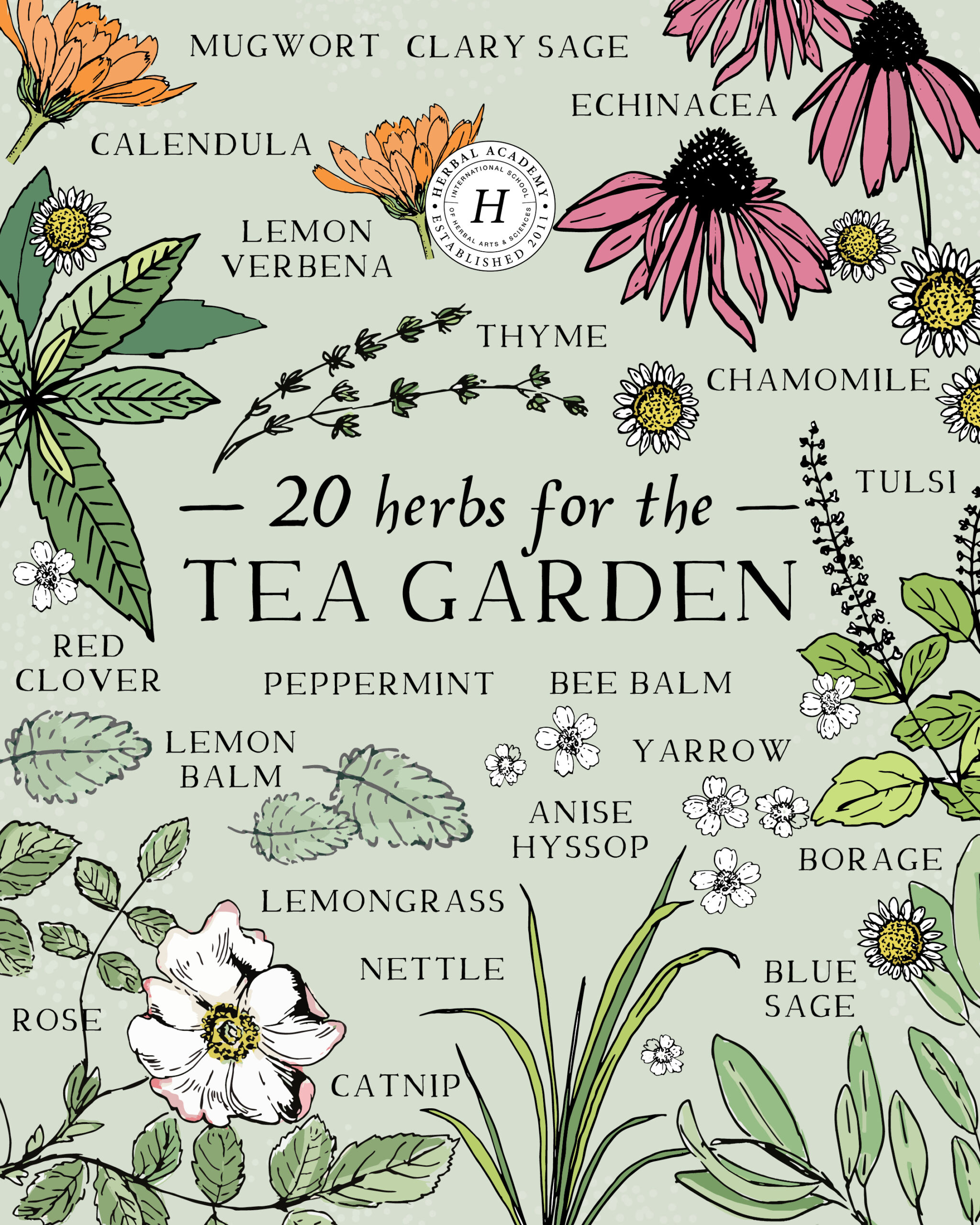
These are the plants you will find growing in my tea/herb garden:
- Lemon balm (Melissa officinalis)
- Rosemary (Rosmarinus officinalis)
- Rose (Rosa spp.)
- Nettle (Urtica dioica)
- Tulsi (Ocimum tenuiflorum)
- Echinacea (Echinacea spp.)
- Yarrow (Achillea millefolium)
- Catnip (Nepeta cataria)
- Blue vervain (Verbena hastata)
- Chamomile (Matricaria chamomilla)
- Bachelor’s button (Centaurea cyanus)
- Wild bergamot or bee balm (Monarda fistulosa)
- Vick’s Plant (Plectranthus tomentosa)
- Peppermint (Mentha piperita)
- Basil (Ocimum basilicum)
- Dill (Anethum graveolens)
- Toothache Plant (Acmella oleracea)
- Red clover (Trifolium pratense)
- Pleurisy root (Asclepias tuberosa)
- St. John’s wort (Hypericum perforatum)
- Ashwagandha (Withania somnifera)
- Sorrel (Rumex acetosa)
- Clary sage (Salvia sclarea)
- Thyme (Thymus vulgaris)
- Borage (Borago officinalis)
- Anise hyssop (Agastache foeniculum)
- Lemongrass (Cymbopogon citratus)
- Lemon verbena (Aloysia citrodora)
- Calendula (Calendula officinalis)
- Nasturtium (Tropaeolum majus)
- Chrysanthemum (Chrysanthemum morifolium)
- Mugwort (Artemisia vulgaris)
- Skullcap (Scutellaria lateriflora)
- Chives (Allium schoenoprasum)
- Blue sage (Salvia azurea)
It’s truly hard to pick favorites, but if I had to pick only three they would be lemon balm, nettle, and tulsi.
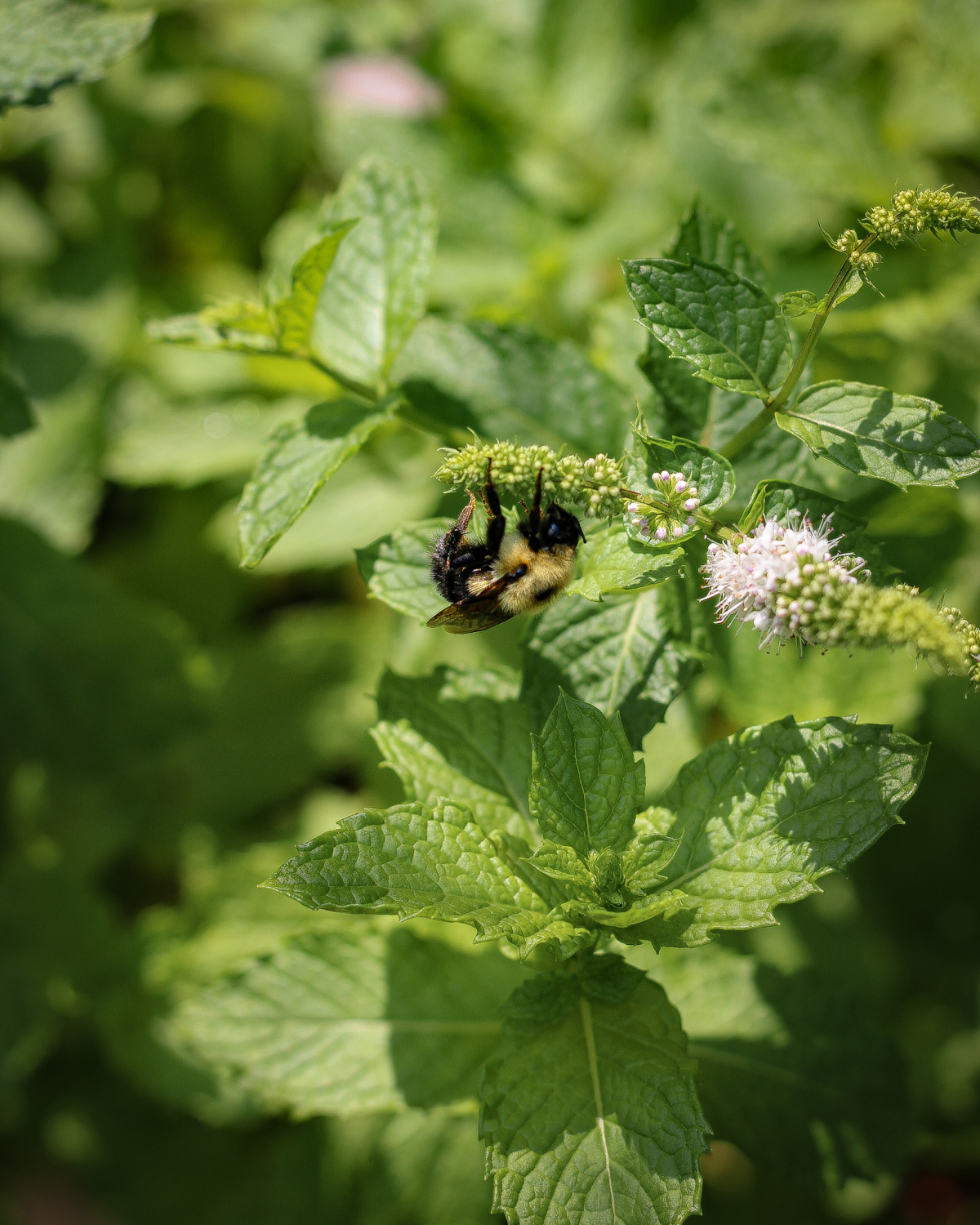
Tea Garden Favorites
Lemon balm is in the mint family and grows prolifically. I find it coming up all over my yard. I welcome each new patch because lemon balm is the herb I use most often for brewing tea. The aroma is soothing and sweet with a little burst of tartness thrown in there for good measure. Lemon balm’s traditional and current uses include: supporting digestive issues, nurturing the nervous system, and used for nausea, fevers, and as a sleep aid (Kuhn & Winston, 2008b).
Nettle (Urtica dioica) is my second most-used herb. It has a light, almost grass-like, flavor. It tastes pleasant blended with most any herb I have growing in the garden. I often use it as a base to which I add other herbs. Nettle is traditionally used to support healthy urinary function. It is also beneficial for upper respiratory health (Mountain Rose Herbs, n.d.). Nettle is high in vitamins A and C and is a good source of quercetin, iron, magnesium, and potassium (Nettle Leaf: Health Benefits, Nutrition Facts, and How to Prepare It, n.d.).
Tulsi (Ocimum tenuiflorum) is somewhat floral in aroma. When added to a tea blend, it is always the first note I smell when going in for a sip. It is a mild adaptogen, meaning it can directly help the body “adapt” to physical, chemical, metabolic, and psychological stressors (Cohen, 2014). Traditionally, tulsi is used to help support stress, diabetes, asthma, and colds (Kuhn & Winston, 2008).
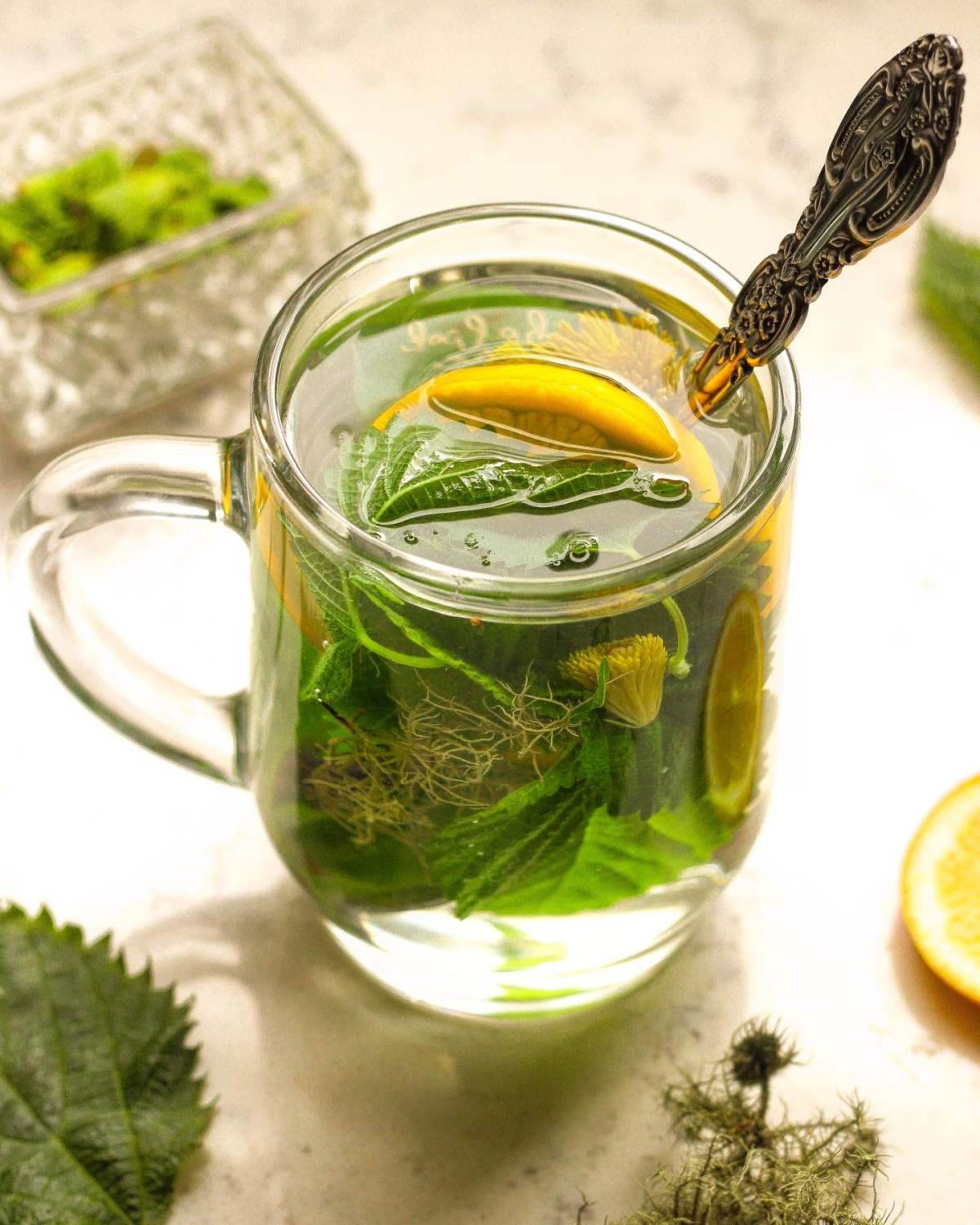
I use the herbs growing in my garden to make both teas and longer-steeped infusions, which are prepared slightly differently. A typical beverage tea uses less plant material. A good guideline is 1 teaspoon-1 tablespoon dried herb per cup of water. A beverage tea steeps for a shorter period of time, usually 5-10 minutes. Teas are usually made using very hot water, but not always. Tea is often made in small batches or simply as a single cup at a time (Carpenter, 2018).
A long-steeped infusion can be made in either warm or cool water. However, warm infusions are more common. Unlike tea, infusions are made in larger batches and with more plant material. Infusions often call for 1-3 tablespoons dried herb per cup of water. Infusions also take longer than tea to make, infusing for several hours or even overnight (Carpenter, 2018).
Shorter-steeped teas are what I make most often using herbs fresh from my garden. I often find myself making tea out of some more unusual ingredients in my garden, as well. For example, one non-traditional tea ingredient that I love using is radish greens! The radish greens are bright and fresh and I often have radishes growing alongside my herbs. In a tea, they impart that same bright, fresh quality. They are packed with vitamins like A, C, and B6 (FoodData Central, 2022). They also contain minerals like magnesium, calcium, and iron. They are particularly enjoyable in a tea with nettle and peppermint.
Tea can be a quick pick-me-up or a soothing way to end your day. As much as I love to begin my day in the tea garden, I often find myself in it before I go to bed as well, gathering lavender, chamomile, and lemon balm to make a soothing nighttime tea that supports my sleep and helps me to unwind. One of my favorite evening blends is a combination of lemon balm, tulsi, lavender, chamomile, and blue vervain, steeped for 10 minutes and finished with local honey and a dash of milk.
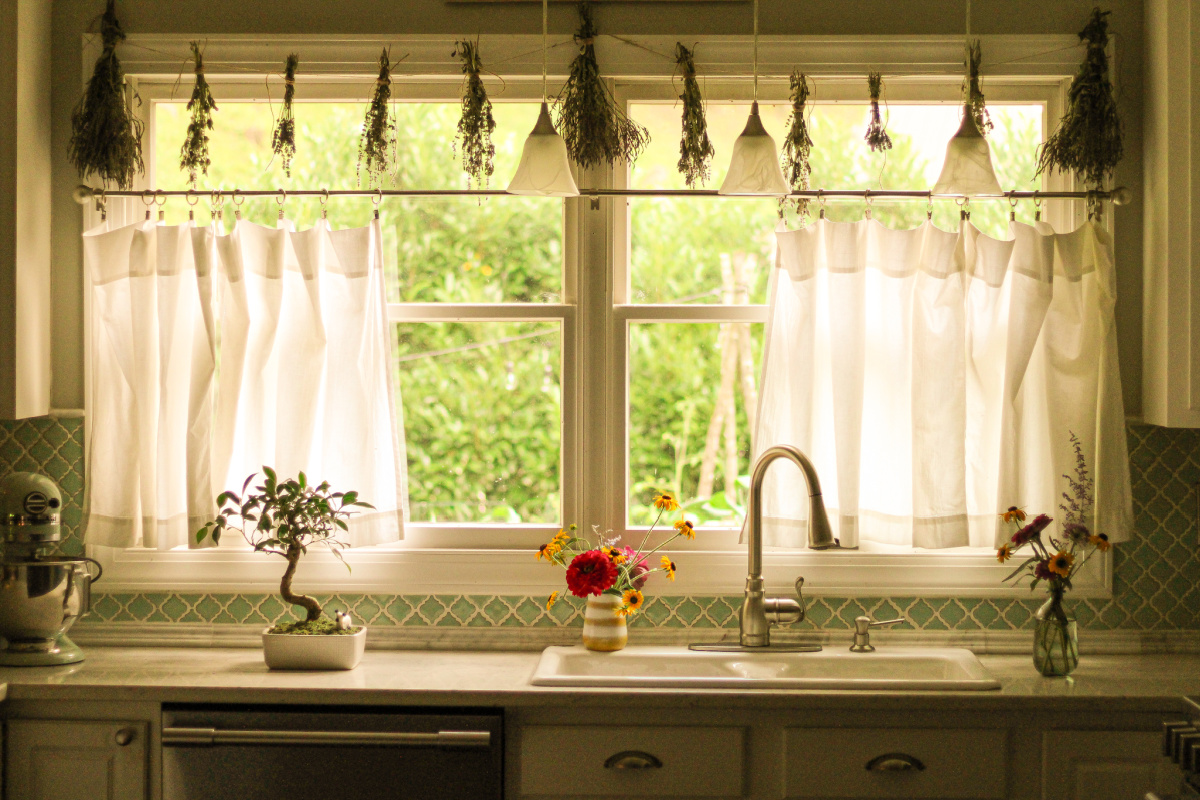
A Problem Of Abundance: What To Do With Excess Tea Herbs
Herbs are best harvested regularly to keep them happy and promote growth. Allowing herbs to flower affects their taste, often making them less flavorful (Slack, 2021). As much as I love herbal tea, it’s still hard to use all of the abundance that my tea garden provides. You may need to be cutting your herbs back every other week or so. This is where drying comes in. In the winter, I crave my teas just as much (if not more) than I do in the summer. Having dried herbs on hand all winter long is such a comfort! Another benefit is that they are packed full of vitamins and nutrients that support our immune systems in the winter. My favorite cold weather tea blend is a combination of nettle, tulsi, rose hips, and thyme, finished off with honey.
Here are a few helpful tips I use when harvesting herbs from my own garden to dry:
- Always harvest in the morning, after the dew has evaporated, and before the sun and heat hit the plant.
- Make sure to use clean shears. This is beneficial both to you and the plant.
- Brush off and remove any organic material, such as bugs and dirt.
- If air-drying herbs, make small bundles to hang using natural twine. Make sure they have room for air to evenly circulate around the bundles. You may also lay them flat on mesh screens to dry. Drying can take a week or longer. Allow them to dry completely before placing them in airtight jars.
- Avoid direct sunlight on your herbs as they are drying and also once dried. Direct sun will cause them to lose flavor. My herbs are dried over my kitchen window, which has bright light with no direct sunlight.
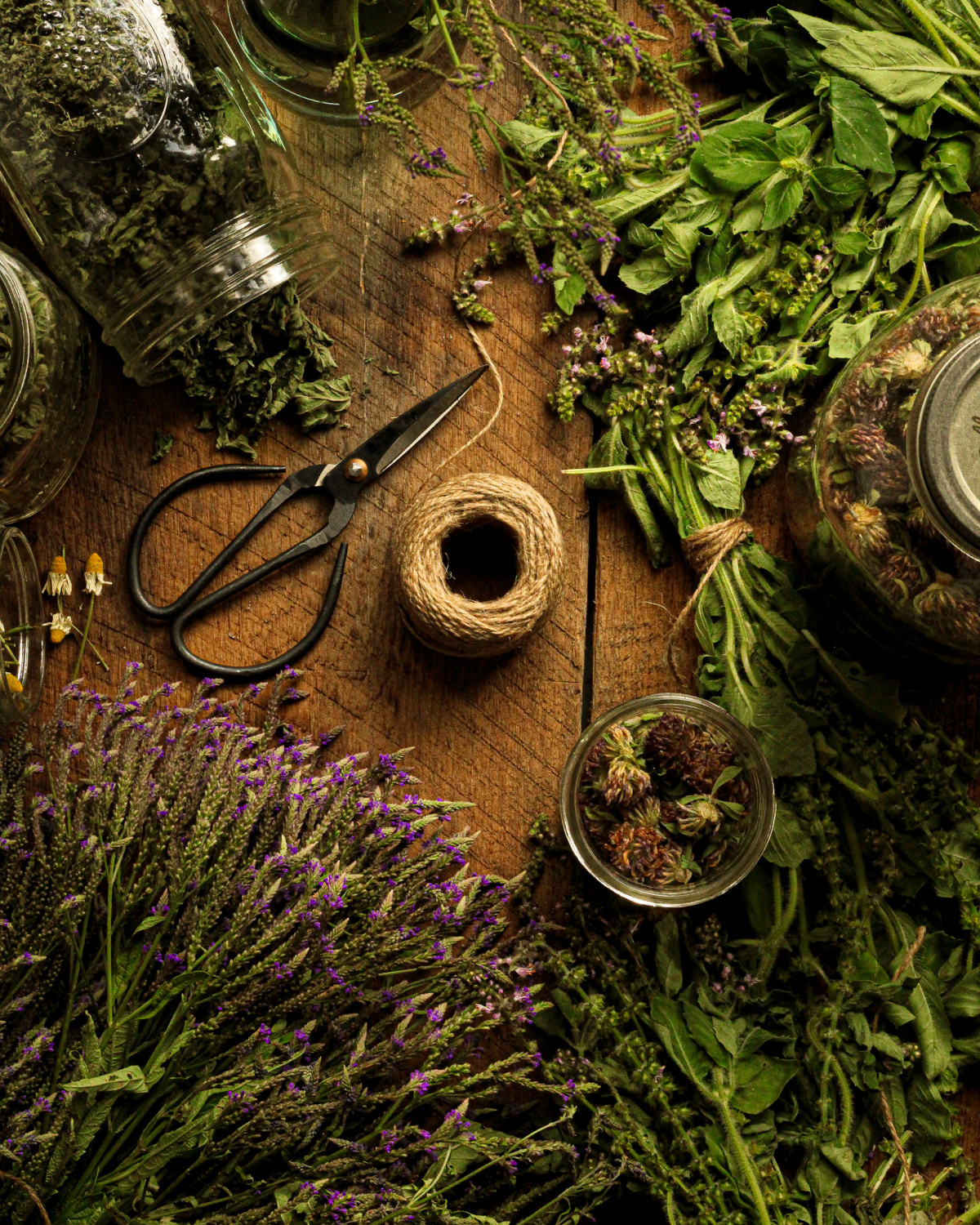
In Closing,
Anyone who enjoys herbal teas regularly understands that tea is an empowering tool for your health and well-being when used with the care and respect it is owed. There is something deeply healing about the ritual of tea. Whether you’re buying tea that’s already dried and blended or you are growing your own tea garden and drying herbs yourself, making tea is a time of thoughtfulness where you are actively nourishing your body. Plants are our companions in this world. We can only hope to provide them with as much love and care as they do us.
A crucial reminder: tea should not be substituted for healthy lifestyle practices such as good sleep habits, exercise, and diet. Having a daily cup of tea is a powerful adjunct to these self-care practices.
Interested in learning more about blending your own tea mixes? Check out our Tea Blending 101 Workshop!
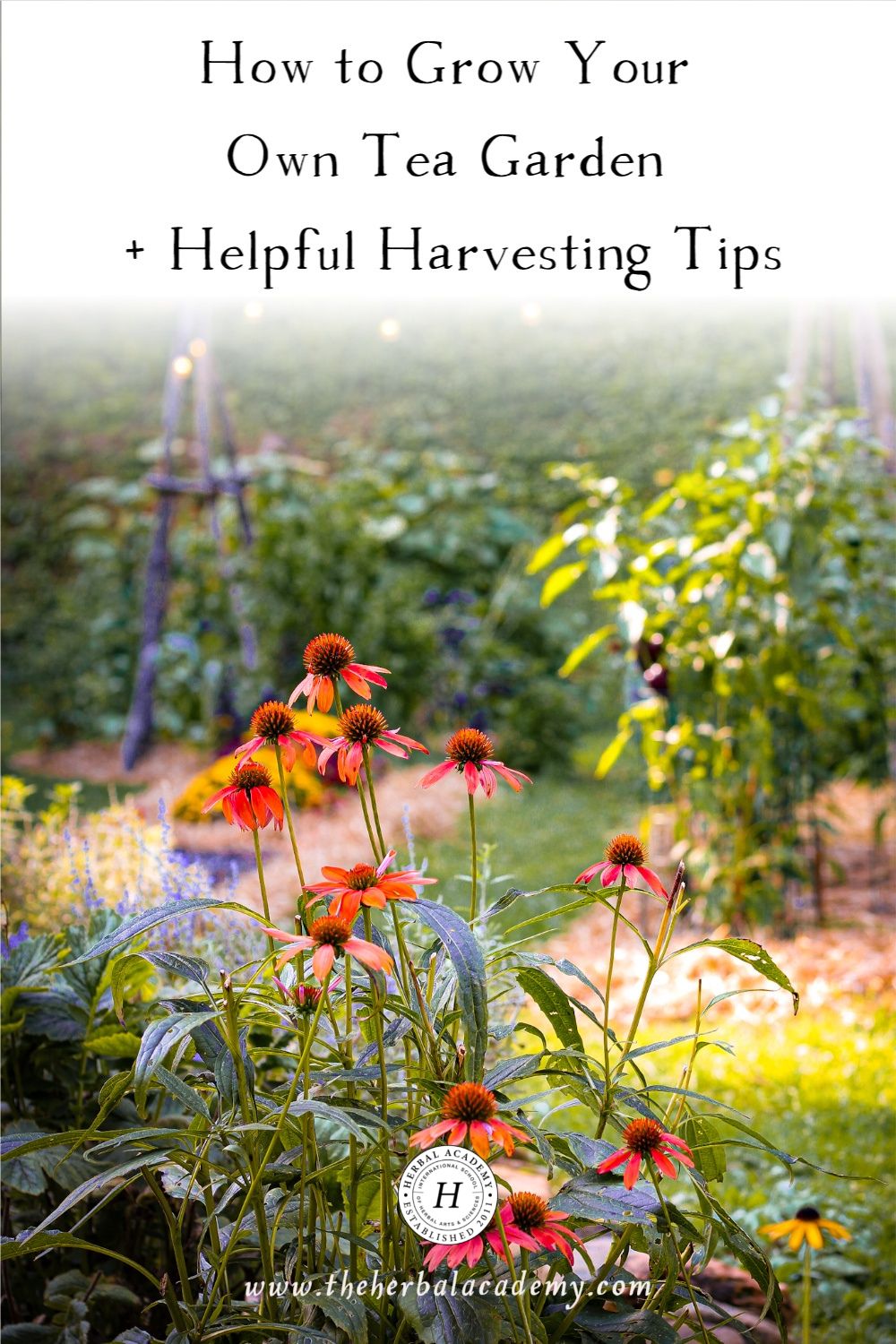
REFERENCES
FoodData Central. (2022, October 30). Fdc.nal.usda.gov. https://fdc.nal.usda.gov/fdc-app.html#/food-details/1103168/nutrients
Carpenter, R. (2018, October 19). Herbal tea or herbal infusion: What’s the difference?. Herbal Academy. https://theherbalacademy.com/herbal-tea-or-herbal-infusion/
Cohen, M.M. (2014). Tulsi – Ocimum sanctum: A herb for all reasons. Journal of Ayurveda and Integrative Medicine, 5(4), 251-259. https://doi.org/10.4103/0975-9476.146554
Iannotti, M. (2022, March 11). Companion planting flowers and herbs in the vegetable garden. The Spruce. https://www.thespruce.com/interplanting-flowers-and-herbs-in-the-vegetable-garden-1402759
Kuhn, M. A., & Winston, D. (2008). Winston & Kuhn’s herbal therapy & supplements: A scientific & traditional approach. Lippincott Williams & Wilkins. https://books.google.com/books?id=sdmXpHlWrZoC&q=ocimum+sanctum#v=snippet&q=ocimum%20sanctum&f=false
Kuhn, M. A., & Winston, D. (2008b). Winston & Kuhn’s Herbal Therapy & Supplements: A Scientific & Traditional Approach. In Google Books. Lippincott Williams & Wilkins. https://books.google.com/books?id=sdmXpHlWrZoC&q=lemon+blam#v=snippet&q=lemon%20balm&f=false
Nettle leaf: Health benefits, nutrition facts, and how to prepare it. (n.d.). WebMD. Retrieved May 25, 2022, from https://www.webmd.com/diet/health-benefits-nettle-leaf
Nettle leaf, North American. (n.d.). Mountain Rose Herbs. Retrieved May 24, 2022, from https://mountainroseherbs.com/north-american-nettle-leaf
Riotte, L. (1998). Carrots love tomatoes : Secrets of companion planting for successful gardening. Storey Pub.









